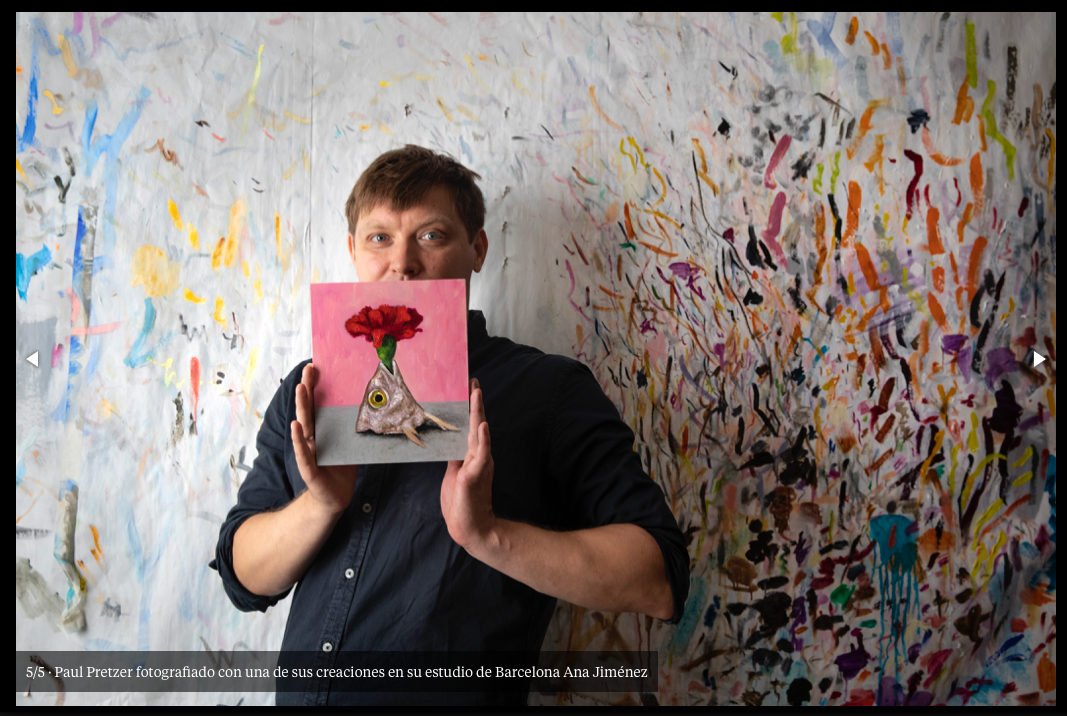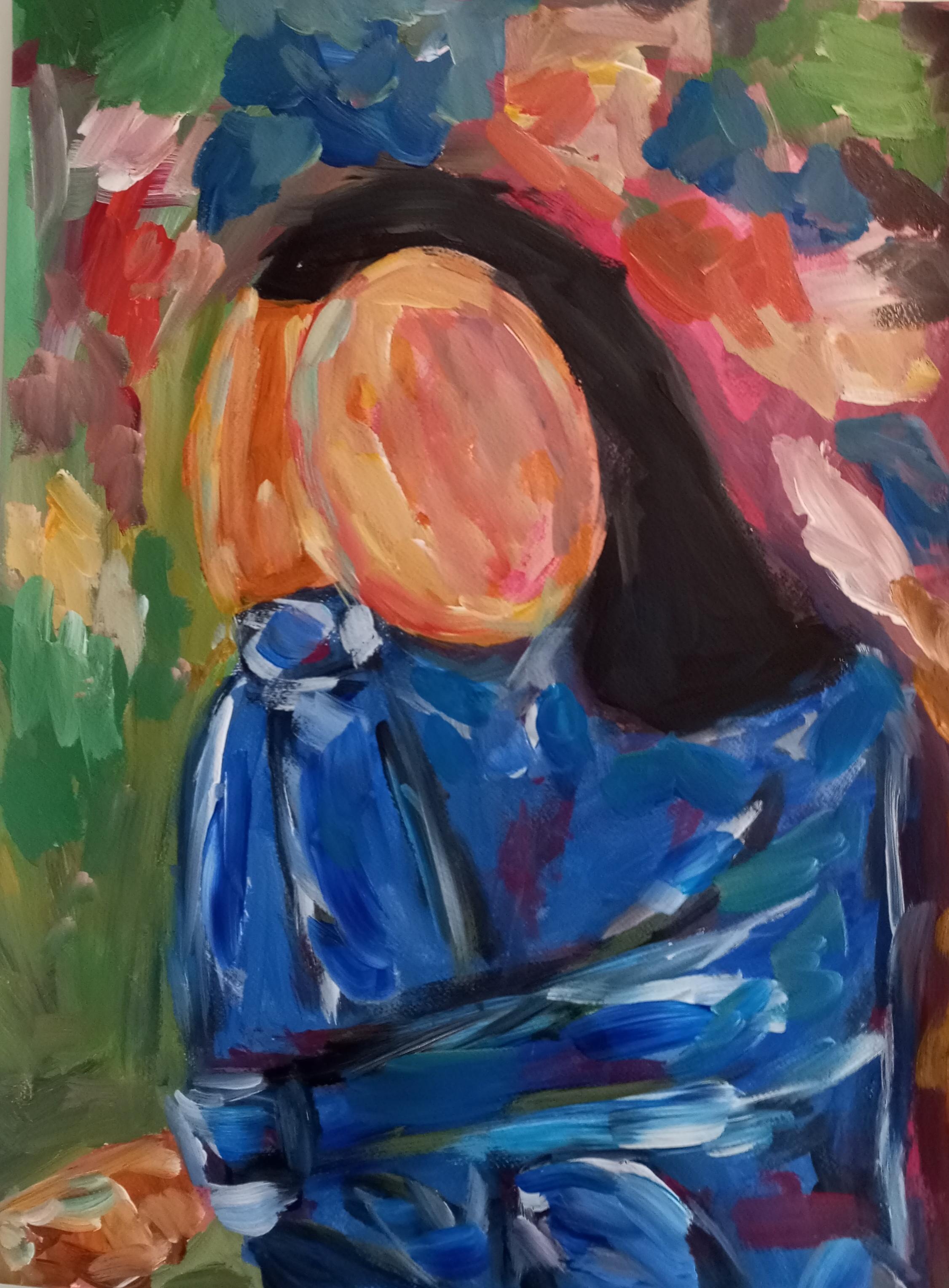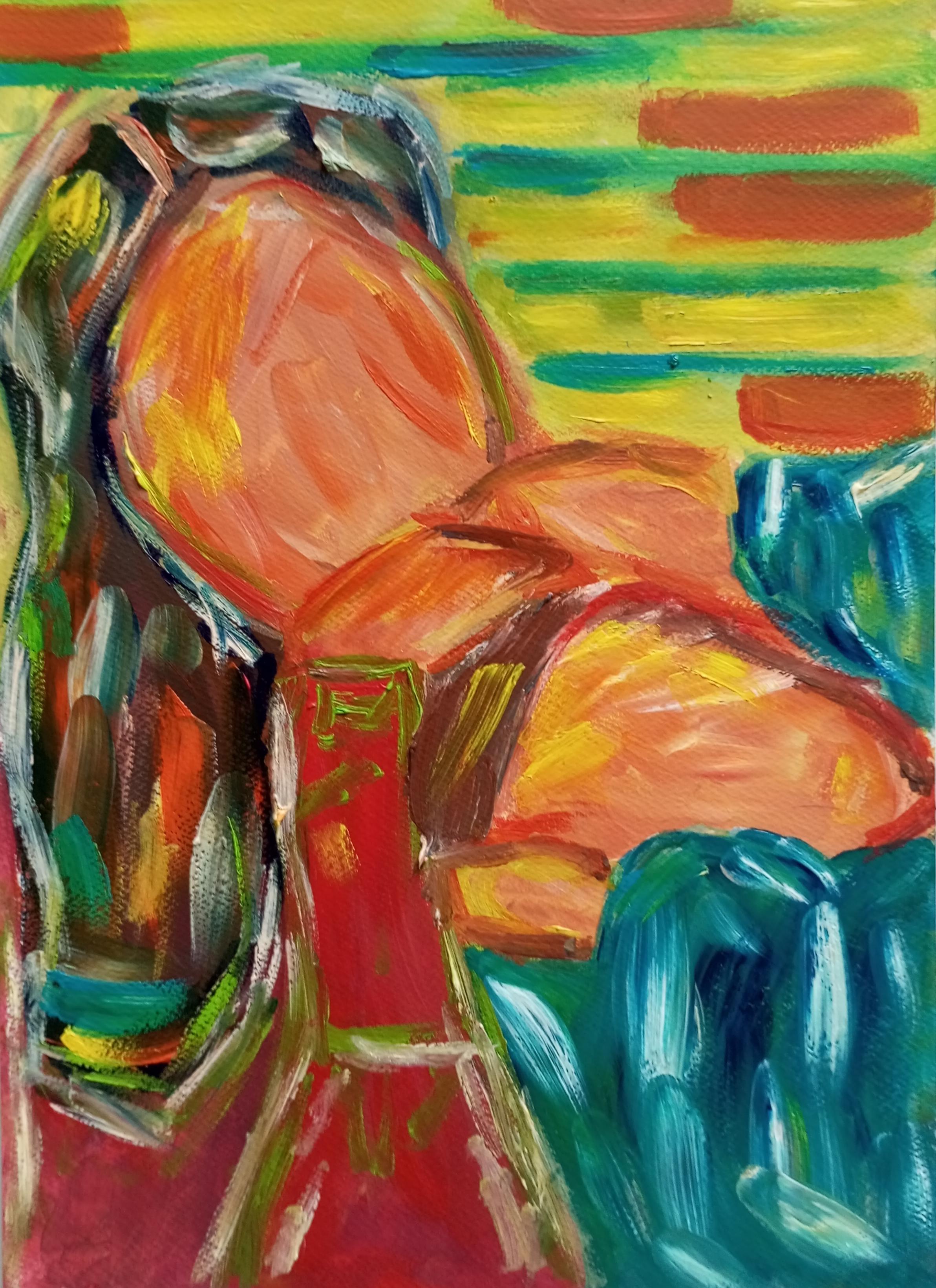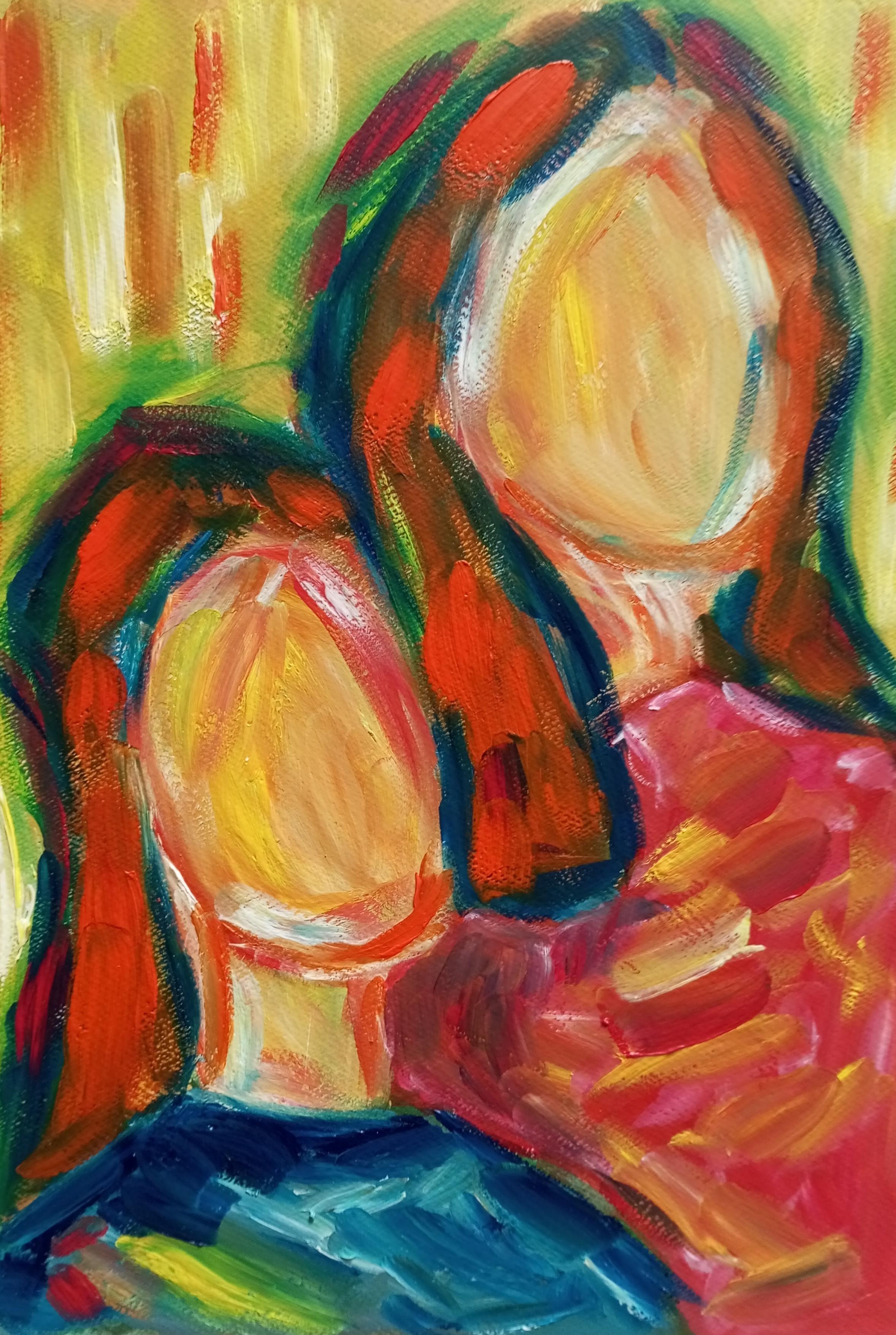Items Similar to Candies Man
Video Loading
Want more images or videos?
Request additional images or videos from the seller
1 of 7
Marc GonzCandies Man2023
2023
About the Item
MARC GONZ
THE HIDDEN GAZE
When confronted with the universe of Marc Gonz, we discover creations that seem to be the result of a working session of a hyperactive action painter who could not stop feverishly adding layers and layers of paint to the canvas. But these beautiful waterfalls with a profusion of colors are obviously not the work of an uncontrolled improvisation. Instead, as a painter, Marc Gonz carefully applies the chosen touches of color to the surface until they take their final, almost sculptural form. What he wants to achieve is a three-dimensional painting that occupies space and not just covers the wall on which it hangs. The artworks look like the stiffened remnants of his artistic process.
The technique Marc uses is close to the classical painting method called "impasto": he mixes his paint on the canvas itself and applies it in such thick layers that the strokes of the brush or painter's knife are clearly visible. In this way, the painting acquires a special texture and it seems as if the paint emerges from the canvas and grows buirently like some kind of fungus or strange unknown plant. 'Impasto painting' was first discovered as a technical experiment in the 17th century when some Baroque style painters tried to represent the volume in folds of clothes or the texture of jewels. Artists like Rembrandt, Frans Hals, and Diego Velázquez attempted Impasto to skillfully depict the minute details like folds, wrinkled skin or the sparkle of elaborately crafted armor, jewellery, and rich fabrics. We also find it in nineteenth-century landscape, naturalist and romantic painting, where it was used by painters like John Constable to convey the raw, rugged tumble of rocks, soil and cliff faces with a rough, experimental energy. In the twentieth century we see how Van Gogh used it to ‘express the turbulent emotions of his artist’s mind'. Also Fauvists like Maurice de Vlaminck or Andre Derrain brought the technique to their experimental territory.
Expressionist and abstract painters like Pollock, Willem de Kooning, Karel Appel or Frank Auerbach went even further and searched for a direct relation with the action of the body and the application of paint on the canvas, by dripping or smearing the paint on the canvas with their hands. And in fact we can also how nowadays painters like Richter, Kiefer or Peter Doig keep exploring the possibilities of texture in paint.
Most of Marc Gonz's recent works are portraits or fragments of human faces: we recognize the shape, see ears, noses and lips of figures that look like young men. What is striking about all
these works is that behind each of these layers of colored paint we can repeatedly discover a human eye as a kind of underlying, central point. It is the only part of the canvas that seems to have been spared from the aggressive splashes of color. It is as if the person portrayed is looking at us from this virgin place, from underneath the various layers. It is a human eye, buried by the overdose of paint. The person portrayed seems to hide behind a bizarre colorful burden of a mask. The works seem unwilling to reveal their true soul.
The artist sometimes describes his works as "winks of foam”. By a "wink" we mean a blink, the rapid opening and closing of an eye, to greet the viewer and give him a sense of complicity.
It is as if from behind each work someone is looking at us, seeming to want to answer our curiosity, yet observing us from behind its protective colorful camouflage.
Marc's works are clearly portraits of people we identify as anonymous, adolescent or younger men. Sometimes he betrays their origins ("Thai eye"/"Candy man"). They often look a bit like clowns with cone-shaped Pierrot hats on their heads. They seem innocent and friendly freaks that emerge from the artist's imagination. The shape of their heads and their entire faces are covered in color, as if a giant, colorful birthday cake was thrown in their faces. The excessive amount of paint does indeed resemble a colored cake and reminds us of the famous Laurel &
Hardy movie "The battle of the Century" in which more than 3,000 whipped cream cakes were used in an epic cake fight. The figure of the comedian and the clown is a melancholic personnage: at the same time victim of accidents and reason for our laughter. They are tragicomic beings whose lives are made up of laughter and tears. We find the same kind of personnages with the filmmaker David Lynch : the main characters of "The elephant Man" and "Eraserhead" are the same kind of melodramatic and strange peronnages.
Indeed, the contours of their monstrous appearance can be somewhat compared to the faces of Marc staring at us.
Like Lynch Marc is fascinated by the mysterious, the spiritual and the occult. He likes to describe his works as meditative exercises who talk about the spirts hidden behind the colorful façade. The artist invites us as viewers to dive in our subconscious and with our eyes scrap the paint away to discover the hidden soul of each work. This way the eyes that are looking at us from behind the abstract surface will reveal us their secret as an echo.
Erich Weiss
2023
- Creator:Marc Gonz (1973, Spanish)
- Creation Year:2023
- Dimensions:Height: 6.7 in (17 cm)Diameter: 51.19 in (130 cm)
- Medium:
- Movement & Style:
- Period:
- Framing:Framing Options Available
- Condition:
- Gallery Location:BARCELONA, ES
- Reference Number:1stDibs: LU1988213492832
DEGREE IN FINE ARTS. University of Barcelona Exhibitions: UXVAL GOCHEZ GALLERY.Barcelona SAATCHI LONDON GALLERY. London FOLD GALLERY. London FERRAN CANO GALLERY. Barcelona NUNOSACRAMENTO GALLERY. Portugal ATELIER RICHELIEU. Paris PALAU OF MUSIC. Valencia. PALAU OF THE VIRREIN. Barcelona ESPAI JAUME MUXART. Barcelona AFFORDABLE ART FAIR. Amsterdam. CLOISTER OF THE ROYAL MONASTERY. Barcelona
Awards: ACCESSIT. PLASTIC ARTS CONTEST. Valencia X COMPETITION OF UNED. Madrid BIENNIAL OF THE MOSTRA D'ART CONTEMPORANI CATALÀ.

About the Seller
No Reviews Yet
Vetted Seller
These experienced sellers undergo a comprehensive evaluation by our team of in-house experts.
Established in 2014
1stDibs seller since 2022
- ShippingRetrieving quote...Ships From: BARCELONA, Spain
- Return PolicyA return for this item may be initiated within 10 days of delivery.
More From This SellerView All
- Swarm BoyLocated in BARCELONA, ESMARC GONZ THE HIDDEN GAZE When confronted with the universe of Marc Gonz, we discover creations that seem to be the result of a working session of a hyperactive action painter ...Category
21st Century and Contemporary Abstract Mixed Media
MaterialsOil
- Horizon n.1Located in BARCELONA, ESI paint the natural phenomenon of rhythm and harmony that continues to flow within me. For example, the patterns, colors, shapes, and energies created by the sky, clouds, sea, waves...Category
2010s Abstract Abstract Paintings
MaterialsAcrylic
- Horizon n. 2Located in BARCELONA, ESI paint the natural phenomenon of rhythm and harmony that continues to flow within me. For example, the patterns, colors, shapes, and energies created by the sky, clouds, sea, waves...Category
2010s Abstract Abstract Paintings
MaterialsAcrylic
- Diluvio verde esmeraldaLocated in BARCELONA, ESÚltimamente mi obra se compone de dos series. La primera llamada “paisajes casi abstractos” con grandes empastes expresionistas de óleo y, una segunda, denominada “Acumulador de torm...Category
2010s Abstract Abstract Sculptures
MaterialsEpoxy Resin
- Diluvio rojo púrpuraLocated in BARCELONA, ESÚltimamente mi obra se compone de dos series. La primera llamada “paisajes casi abstractos” con grandes empastes expresionistas de óleo y, una segunda, denominada “Acumulador de torm...Category
2010s Abstract Abstract Sculptures
MaterialsEpoxy Resin
- Pensares ILocated in BARCELONA, ESMi obra intenta emprender un viaje hacia lo profundo de nuestra naturaleza esencial, dando cabida a una visión más intimista para elaborar un discurso artístico que invite a la refle...Category
2010s Abstract Abstract Sculptures
MaterialsWood
You May Also Like
- "I am here for you"Located in VÉNISSIEUX, FRI enjoy working on impressionist artworks with an expressive touch. This artwork makes part of one of my favorite series dedicated to women whom I always want to represent as strong,...Category
2010s Abstract Impressionist Portrait Drawings and Watercolors
MaterialsOil
- "I'll strengthen you "Located in VÉNISSIEUX, FRI enjoy working on impressionist artworks with an expressive touch. This artwork makes part of one of my favorite series dedicated to women whom I always want to represent as strong,...Category
2010s Abstract Impressionist Portrait Drawings and Watercolors
MaterialsOil
- "Sensitivity"Located in VÉNISSIEUX, FRThis artwork makes part of my new period in my artistic expression. This painting dedicated to "Women" series is a special one since it is all about my strong deep personal transfor...Category
2010s Abstract Impressionist Portrait Drawings and Watercolors
MaterialsAcrylic
- untitled Woman by the WindowsBy Karl Albert BuehrLocated in Fairlawn, OHUntitled (Woman by the Windows) Unsigned. Pastel on board, c. 1915 Created while the artist was in Giverny, France Provenance: Gift of the artist to his wife, Mary Hess Buehr by Descent to the artist's niece, daughter of Will Hess. David Salzman Robert Henry Adams Fine Art, Chicago Ronald C. Sloter, Columbus One of the early Chicago artists to adopt Impressionism, Karl Buehr became a figure and landscape painter. As a figure painter, his specialty became "gorgeously colored images of young women on porches overlooking brilliant summertime gardens." (Kennedy 98) His later work often showed a female figure with serious expression engaging the viewer with a direct stare. In his landscapes, he was noted for his strong coloration. In a December 1896 student exhibition at the Art Institute, a reviewer for the "Chicago Times Herald" described Buehr's landscapes as "blithe and joyous" with "country roads brilliant in sunlight . . . fields rich in summer verdure, under soft skies painted in a high, musical key." (Gerdts 68) Buehr was born as one of seven sons to a prosperous German family who immigrated to America and settled in Chicago in 1869. He was first exposed to his signature style of Impressionism in 1888 when he enrolled in night classes at the Art Institute while working in the shipping department of a lithographic firm near the Institute. He remained a student there until 1897 and was recognized in a "Chicago Times Herald" editorial of June 13, 1897 as one of the Institute's most outstanding pupils. The next year, his art career was temporarily put on hold when he briefly enlisted with the U.S. Army in the Spanish American War. In 1899, he resumed his art studies, this time with Frank Duveneck. He exhibited a painting at the Paris Salon of 1900. In 1905, thanks to a wealthy Chicago patron, Buehr and his family moved to France. They spent the following year in Taormina, Sicily, and spent time in Venice as well. In Paris, Buehr studied at the Academy Julian with Raphael Collin for two years. Then he went to England, enrolling in the London Art School but had returned to Paris by 1908. During this time, he began painting at Giverny, the home of Impressionist leader Claude Monet (1840-1926, and by 1912, Buehr was listing that village as his home address. One of his good friends and associates at Giverny was Frederick Frieseke. One of Buehr's paintings from that time, "News from Home", was exhibited in 1913 at the French Salon in Paris and at the annual exhibit of the Chicago Art Institute. It shows a woman in floral dress sitting on a porch with a background with potted flowers and lush greenery background. Of his painting done at Giverny, Buehr wrote in 1912 to William Macbeth of Macbeth Galleries in New York: "My figures painted in and around Giverny are costumed and in appropriate out door settings." (Gerdts 68) In 1914, he returned to the United States and took a teaching position in Chicago at the Art Institute, which he held for the remainder of his life. He was married to Mary Hess, a painter of miniatures and decorative works. In 1928-29, he was a guest artist at Stanford University. Courtesy: AskArt “Karl Albert Buehr (1866–1952) was a painter born in Germany. Buehr was born in Feuerbach - near Stuttgart. He was the son of Frederick Buehr and Henrietta Doh (Dohna?). He moved to Chicago with his parents and siblings in the 1880s. In Chicago, young Karl worked at various jobs until he was employed by a lithograph company near the Art Institute of Chicago. Introduced to art at work, Karl paid regular visits to the Art Institute, where he found part-time employment, enabling him to enroll in night classes. Later, working at the Institute as a night watchman, he had a unique opportunity to study the masters and actually posted sketchings that blended in favorably with student's work. Having studied under John H. Vanderpoel, Buehr graduated with honors, while his work aroused such admiration that he was offered a teaching post there, which he maintained for many years thereafter. He graduated from the Art Inst. of Chicago and served in the IL Cav in the Spanish–American War. Mary Hess became Karl's wife—she was a student of his and an accomplished artist in her own right. In 1922, he was elected into the National Academy of Design as an Associate member. Art Studies in Europe In 1904, Buehr received a bronze medal at the St. Louis Universal Exposition, then, in 1905, Buehr and his family moved to France, thanks to a wealthy Chicago patron, and they spent the following year in Taormina, Sicily, where the artist painted local subjects, executing both genre subjects and landscapes as well as time in Venice. Buehr spent at least some time in Paris, where he worked with Raphaël Collin at the Académie Julian. Giverny and American Impressionism Prior to this time, Buehr had developed a quasi-impressionistic style, but after 1909, when he began spending summers near Monet in Giverny, his work became decidedly characteristic of that plein-air style but he began focusing on female subjects posed out-of-doors. He remained for some time in Giverny, and here he became well-acquainted with other well known expatriate America impressionists such as Richard Miller, Theodore Earl Butler, Frederick Frieseke, and Lawton Parker. It seems likely that Buehr met Monet, since his own daughter Kathleen and Monet’s granddaughter, Lili Butler, were playmates, according to George Buehr, the painter’s son. His other daughter Lydia died before adulthood due to diabetes. He returned to Chicago at the onset of World War I and taught at The Art Inst for many years. One of his noted pupils at the Art Institute was Archibald Motley...Category
1910s Abstract Impressionist Drawings and Watercolor Paintings
MaterialsPastel
- Carolyn (Arms raised to her head)By Louis Oscar GriffithLocated in Fairlawn, OHCarolyn (Arms raised to her head) Graphite on laid paper Unsigned Provenance: Estate of the artist by descent to his Grandson Depicts the artist's wife Carolyn. Most probably created in Nashville, Indiana Related to the painting entitled "Maiden" in the Haan Museum, Lafayette, IN (see photo) Condition: Excellent Archival framing with TruVue Conservation Clear glass Image size: 10 3/4 x 8 1/2 inches Frame size: 18 7/8 x 16 inches Louis Oscar Griffith (1875-1956) Born in Greencastle, Indiana, Griffith grew up in Dallas, Texas where Texas artist and teacher Charles Franklin Reaugh recognized young “Griff’s” artistic talent. At age 18, Griffith moved to St. Louis where he attended the St. Louis School of Fine Arts. In 1895, he moved to Chicago where he worked making color prints for the firm Barnes and Crosby. He attended the Art Institute of Chicago and during a brief stay in New York, the National Academy of Design. A successful commercial artist with a studio in the Chicago Loop, Griffith was a member and president of the Chicago Palette and Chisel Club. He made his first trip to Brown County...Category
1920s Abstract Impressionist Portrait Drawings and Watercolors
MaterialsGraphite
- Sophia BrunhardLocated in Atlanta, GAYou meet the Spanish artist Alexandro Santana and you think, cripes, can he be for real? So handsome, so flamboyant, so seductive, so amusing -- you’...Category
21st Century and Contemporary Abstract Impressionist Portrait Drawings a...
MaterialsPencil
Recently Viewed
View AllMore Ways To Browse
Illustration Suzy Parker
Beds New Orleans
Harbor Island 1970
Lady Oscar
American Art Brock
Chelsea Map
French Classical Painting Garden Scene
Japanese High Boy
Ken Little
Alphabet R
Hunt Slonem Original Rabbits
Joan Miro Hand Signed Aquatint Etching
South American Embroidery
Sydney Bush
1988 Dior Spring Summer
Barbara Jones
Marilyn Monroe Mugs
Old Dictionary Books






